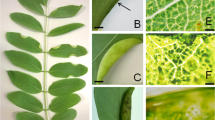Abstract
The weights of pecanCarya illinoensis Koch galls caused by several species ofPhylloxera (Homoptera: Phylloxeridae) were negatively correlated with leaf and nut weights and nut production. Several allelochemicals (isoquercitrin, juglone, and 2 proanthocyanidins) were isolated from galls, and their antibiotic potentials were estimated, based on their toxicity to the bacteriaPseudomones maltophilia (Hugh et Ryschenkow). Pecan proanthocyanidins (condensed tannins) were characterized for the first time, and their stereochemistry was elucidated. The protein and total sugar contents of total leaves and leaf surface washings were determined. The leaf surface sugar content was very low, suggesting that the puncturing strategy of this insect may be for the purpose of finding sugars. The plant growth hormones gibberellic acid, zeatin, zeatin riboside, kinetin, indole acetic acid, and abscisic acid were found in pecan leaves, stems, and their galls. Gibberellic and abscisic acids were present in highest concentrations in all tissues, but lower in galled tissues, suggesting that increased biosynthesis by pecan plant growth regulators did not occur in response to insect attack.
Similar content being viewed by others
References
Binks, R., MacMillan, J., andPryce, R.J. 1969. Plant hormones VIII. Combined gas chromatography-mass spectrometry of the methyl esters of gibberellins A1 and A24 and their trimethylsilyl esters.Phytochemistry 8:271–284.
Boethel, D.J., andEzell, J.E. 1977. PecanPhylloxera: Pictorial life history.Pecan South. 4:52–59.
Boethel, D.J., Eikenbary, R.D., Morrison, R.D., andCriswell, J.T. 1976. Pecan weevil,Curculio caryae, (Coleoptera: Curculionidae): 1. Comparison of adult sampling techniques.Can. Entomol. 108:11–18.
Bradford, M.M. 1976. A rapid and sensitive method for the quantitation of microgram quantities of protein utilizing the principle of protein-dye binding.Anal. Biochem. 72:248–254.
Byers, J.A., Brewer, J.W., andDenna, D.W. 1976. Plant growth hormones in pinyon insect gails.Marcella 39:125–143.
Carpenter, T.L., Neel, W.W., andHedin, P.A. 1979. A review of host plant resistance of pecan,Carya illinoensis, to Insecta and Acarina.Bull. Entomol. Soc. Am. 25:251–257.
Czochanska, Z.,Foo, L.P.,Newman, R.H.,Porter, L.J., andThomas, W.A.1979. Direct proof of a homogenous polyflavan-3-ol structure for polymeric proanthocyanidins.J. Chem. Soc. Chem. Commun. 375–377.
Czochanska, Z., Foo, L.P., Newman, R.H.andPorter, L.J. 1980. Polymeric proanthocyanidins. Stereochemistry, structural units, and molecular weight.J. Chem. Soc. Perkin 1:2278–2286.
Elliger, A., Chan, B.G., andWaiss, A.C., Jr. 1980. Flavonoids as larval growth inhibitors.Naturwissenschaften 67:358–359.
Feeny, P.A. 1968. Effect of oak leaf tannins on larval growth of the winter mothOperophtera brumata.J. Insect Physiol. 14:805–817.
Foo, L.Y., andPorter, L.J. 1983. Synthesis and conformation of procyanidin diastereoisomers.J. Chem. Soc. Perkin Trans I:1535–1543.
Gupta, R.K., andHaslam, E. 1978. Plant proanthocyanidins. Part 5. Sorghum polyphenols.J. Chem. Soc. Perkin I:892–896.
Hardin, J.M., andStutte, C.A. 1981. Analysis of plant hormones using high-performance liquid chromatography.J. Chromatogr.k 208:124–128.
Hedin, P.A., Langhans, V.E., andGraves, C.H. Jr. 1979. Identification of juglone in pecan as a possible factor of resistance toFusicladium effusum.J. Agric. Food Chem. 27:92–94.
Hedin, P.A., Collum, D.H., Langhans, V.E., andGraves, C.H., Jr. 1980. Distribution of juglone and related compounds in pecan and their effect onFusicladium effusum.J. Agric. Food Chem. 28:340–342.
Hedin, P.A., Jenkins, J.N., Collum, D.H., White, W.H., andParrott, W.L. 1983. Pages 347–365, Chapter 20,in P.A. Hedin (ed.) Plant Resistance to Insects. ACS Symposium Series 208, American Chemical Society, Washington, D.C.
Skuhravy, V., Skuhrava, M., andBrewer, J.W.(1980). Evaluation of plant damage caused by three species of gall midges (Diptera: Cecidomyiidae). Z.Angew. Entomol. 90:184–190.
Stoetzel, M.B. 1981. Two new species ofPhylloxera (Phylloxeridae: Homoptera) on pecan.J. G. Entomol. Soc. 16(2):127–144.
Stoetzel, M.B., andTedders, W.L. 1981. Investigation of two species ofPhylloxera on pecan in Georgia.J. G. Entomol. Soc. 16(2):144–150.
Waage, S.K., andHedin, P.A. 1983. Unpublished data, USDA, Mississippi State, Mississippi 39762.
Author information
Authors and Affiliations
Additional information
Juglandales: Juglandaceae.
Homoptera (Heteroptera): Phylloxeridae.
Mention of a commercial or proprietary product in this paper does not constitute endorsement of this product by USDA or Mississippi State University.
Mississippi Agricultural and Forestry Experiment Station Journal Article 5830.
Rights and permissions
About this article
Cite this article
Hedin, P.A., Neel, W.W., Burks, M.L. et al. Evaluation of plant constituents associated with pecan phylloxera gall formation. J Chem Ecol 11, 473–484 (1985). https://doi.org/10.1007/BF00989558
Received:
Accepted:
Issue Date:
DOI: https://doi.org/10.1007/BF00989558




